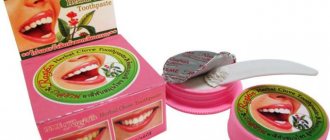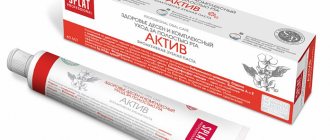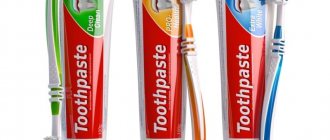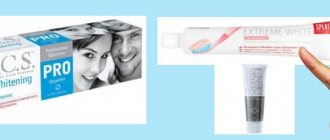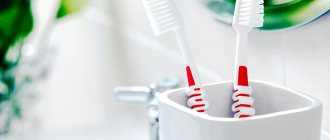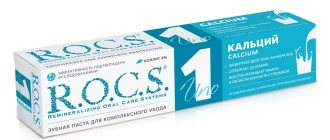Strong and beautiful teeth are every person’s dream. That is why special attention should be paid to proper oral hygiene. Toothpaste is an integral part of daily dental and gum care. It can not only maintain oral health, but also reduce the manifestations of various dental diseases. And today we will tell you everything about toothpastes, how to choose, what to look for in the composition, where to buy them.
How many of us buy toothpaste? They make a shopping list, go to the hypermarket and take the first one they come across. If this sounds like you, then most likely you underestimate the role of toothpaste in your health. A good toothpaste protects against caries, ensures that teeth do not lose minerals, and most importantly, does not harm the enamel.
In this article we will analyze in detail the compositions of modern toothpastes and tell you how to choose the right toothpaste.
Prevention of caries
Caries is the most common disease in the world. This is a pathological process of destruction of hard tooth tissues. It begins with a white spot and ends with pulpitis and various septic processes with inevitable tooth loss.
The main cause of caries is bacteria that produce acids. They wash fluoride and calcium out of the tooth tissue and weaken it. Frequent consumption of sweets accelerates the development of carious bacteria: carbohydrates are a favorite environment for their reproduction. Teeth with thinned enamel are also at risk: through microcracks, bacteria penetrate into the dentinal tubules and begin to destroy the tooth from the inside.
The most important stage in effectively combating caries is early diagnosis of the problem and, of course, prevention. Remove plaque at least once every 12 hours, and visit the dentist every 6 months!
In addition to caries, the TOP 5 most common dental problems are:
- Raid.
- Unpleasant smell.
- Sensitive enamel.
- Bleeding gums.
- Color change.
Making your own tooth powder at home
You can make your own tooth powder. A homemade product will definitely be natural and, accordingly, harmless and even useful.
The recipe may contain the following components:
- 2 tablespoons of baking soda;
- 1 tablespoon ground turmeric.
- 60 g white clay;
- 1-2 tablespoons of Himalayan salt;
- Essential oil of tea tree, mint, orange;
After thoroughly mixing all the ingredients, the powder can be used.
Types of pastes
According to dentists, the best paste is the one that fully meets the needs of a particular person. Modern manufacturers have significantly expanded the range of their products. And now it is not just a means for cleansing plaque, but also an indispensable assistant in the fight against inflammatory processes, increased sensitivity of enamel, initial carious processes and many other problems. This is unconditional progress, but along with it another problem has appeared: an incorrectly selected product may not only not bring the desired result, but also cause harm.
But first, let's discuss the types of pastes. According to GOST 7983-99, all toothpastes are divided into:
- hygienic,
- therapeutic and prophylactic.
Hygienic pastes are designed for mechanical removal of food debris and plaque from enamel. They contain no drugs.
Therapeutic and prophylactic pastes are intended for the prevention of various oral diseases: caries, gingivitis, periodontal disease. Such pastes have antiseptic and anti-inflammatory effects.
Choice
Natural toothpastes must be selected depending on the individual characteristics of the teeth, as well as taking into account the specific needs of the oral cavity for a particular care.
Pastes have different compositions in accordance with their basic properties. Some are focused on whitening, others on protection, and still others on reducing hyperesthesia.
- The ideal components in toothpastes suitable for sensitive teeth are plant extracts. They will help get rid of pain when taking cold and hot drinks, as well as food. But it is better to avoid the content of coarse abrasive components, sulfates and ingredients that have the property of intense bleaching;
- If you are confident that there is a sufficient amount of fluoride in the diet, you should pay attention to pastes without it. In them, this substance is replaced with a component of organic origin that can perform similar functions without harm to health. This is, for example, algin.
- For bleeding gums, products containing herbal extracts, vitamins, especially B12, and oils are suitable. These ingredients will help relieve gum inflammation and their subsequent restoration;
- natural toothpastes, unlike mass-market products, are able to whiten teeth carefully, without destroying the enamel with harsh abrasive components. In such pastes they are usually replaced with small particles of silicon. Those wishing to achieve a snow-white smile should pay attention to the cleaning product from Logona;
Properties of toothpastes
When choosing a paste, it is important to pay attention to its abrasiveness, composition, consistency and taste. A properly selected paste will not only bring benefits, but will also make the cleaning process more enjoyable.
The abrasiveness of the toothpaste determines the intensity of the impact on the enamel. The degree of abrasiveness depends not only on the number of abrasive particles, but also on their size. The larger they are, the more they polish the enamel. The number and size of particles form the abrasiveness index, which is indicated on the paste packaging by the abbreviation RDA.
Types of RDA:
- RDA 0 - for children under 2 years old.
- No more than RDA 20 - for children from 2 years old.
- RDA from 20 to 50 - for sensitive teeth and gums.
- RDA from 50 to 80 - for normal teeth.
- RDA from 80 to 110 - for polishing enamel if you need a slight brightening effect (they should not be used daily).
- Above RDA 110 - for intense brightening effects (not recommended for chips and cracks of enamel, as well as for increased tooth sensitivity).
Due to the fact that children's enamel is even more sensitive than adult enamel (the surface of a child's tooth is much softer and contains fewer minerals), the composition of a child's toothpaste should contain abrasive substances to a minimum. Among them are soda and titanium dioxide. Such elements can activate sensitivity and damage dental tissue in children.
When choosing a paste, pay attention not only to its purpose, smell or taste, but also to its composition!
Fluorides: pros and cons
This may seem surprising to some, but fluoride can cause irreparable harm to the human body. This can happen if there is an excess of this substance. When consuming the norm, fluoride is even useful, because it performs a number of important functions, such as:
- increasing the strength characteristics of bones;
- acceleration of bone tissue regeneration in case of injuries (fractures), etc.
- influence on the growth and condition of nails, teeth and hair;
- ensuring caries prevention;
- activation of the body's defenses;
- prevention of osteoporosis;
- helping the body absorb iron;
- participation in the hematopoietic process;
At the same time, fluorine is a strong oxidizing agent, and its excess negatively affects bone tissue and tooth enamel. This chemical can cause mottled teeth, bleeding gums and weak limbs. That is, an excess of fluoride is much more dangerous than its deficiency.
When excess Fluorum enters the body over a period of 1-2 decades, bone fluorosis inevitably begins to develop, causing osteoporosis, osteosclerosis and osteosarcoma.
In children, with excessive concentrations of this substance, even before the teething stage, endemic fluorosis, which is a chronic lesion of tooth enamel, can develop. This disease is characterized by the appearance of spots of different shapes and sizes.
Some countries have even banned (or partially limited) water fluoridation. These include: Sweden, Luxembourg, France, Belgium, Israel, Japan, China and others.
It is worth noting that a person receives a sufficient amount of fluoride without using a paste containing it. To confirm this, a simple example can be given. The norm for an adult is fluoride consumption in an amount of about 2 mg.
If you drink 2 liters of water, eat a few apples and add rice or buckwheat to your diet, the result will be the required 2 mg of daily requirement. After all, water on average contains 0.5 mg of fluoride per liter; two apples contain approximately the same amount of this substance, which is already 1.5 mg.
Buying toothpaste without fluoride or containing it is everyone’s business. Among the manufacturers of natural products, there are also very worthy options that produce organic cleaning products with a small concentration of sodium fluoride. This is, for example, organic people.
What components to look for?
Calcium is the main element of the skeletal system. This mineral strengthens teeth and protects them from caries. Paste with calcium can eliminate caries in the initial stage.
Zinc citrate is an antiseptic that blocks the growth of bacteria and the hardening of minerals that form tartar.
Xylitol is one of the most effective natural components for protection against caries. Actively fights bacteria, restores enamel and increases its strength, moisturizes the oral cavity.
Papain and bromelain are natural enzymes that lighten enamel naturally. They give a more delicate and not as strong whitening effect as peroxides.
Natural extracts are natural anti-inflammatory and antiseptic components that can be used daily. Effective complementary therapy for minor bleeding and inflammation of the gums.
Hydroxyapatite is a modern and effective means for restoring and renewing enamel. Fills microcracks and prevents the formation of caries.
Peptides are organic substances that restore damaged gum tissue by normalizing its functioning at the cellular level.
Benefits of natural remedies
The most important advantage of natural cosmetics is the natural origin of the components included in its composition, which not only perfectly cope with their functions, but also do not harm health.
There is an opinion that natural teeth cleaning products are also not able to effectively cope with problems such as whitening, for example, or decreased sensitivity. But this is just a misconception. In fact, natural ingredients can take just as good care of a person’s oral cavity.
In addition, several more significant advantages of natural-based paste should be highlighted:
- Most of these products are certified. And this indicates their unconditional safety and high quality;
- packaging is often self-degrading, which also, albeit to a small extent, helps preserve nature.
- they are not tested on animals;
- when producing products with a natural composition, there is no release of harmful substances into the atmosphere due to the absence of synthetic components;
Toothpastes - how to choose the right one
A good oral care product should not only be effective, but also be as safe as possible. Some manufacturers saturate their products with components, a high concentration of which can cause serious harm to human health in general.
Products based on plant components do not contain harsh chemicals and provide gentle cleansing. Essential oils and extracts of medicinal plants must be supplemented with surfactants (surfactants) - without them, high-quality cleansing is impossible. It’s another matter if the surfactants themselves are of a plant nature, and then we can confidently call the product completely natural. This is a good choice for children as well as adults!
Criterias of choice:
- A type of pasta.
As mentioned above, you need to choose a product based on individual needs and indications. If there are no problems with your teeth and gums, a prophylactic paste would be the best option. If there are problems with the enamel or the condition of the mucous membrane, it is worth considering treatment and preventive options. But in this case, you must first consult a dentist.
- Ingredients included.
Be sure to read the ingredients carefully before purchasing. If there are allergy sufferers in the family, it is important to make sure that there are no components that can provoke allergic reactions.
- Degree of abrasiveness
The presence of abrasive particles ensures high-quality mechanical cleaning of plaque and allows you to return your teeth to their natural whiteness. On the other hand, too long exposure of this kind leads to injury to the enamel, its thinning and hyperesthesia.
- Taste and smell
As for taste and smell, these criteria are left to the discretion of the user. Sometimes a too strong taste can cause unpleasant sensations or even gag reflexes - this also needs to be taken into account.
Adult toothpastes
Such toothpastes have the ability to eliminate pathogenic bacteria and freshen breath. Prevents the appearance of plaque and tartar.
✅Toothpaste “Comprehensive care” LAVERA
The toothpaste contains organic echinacea and calcium, which have an anti-inflammatory effect on the gums and improve the health of the oral cavity.
The highly effective fluoride-free formula is rich in natural minerals, gently cleanses, protects the oral cavity from bacteria and freshens breath! With regular use, it prevents the appearance of tartar. Suitable for children. Does not contain fluorine and microplastics.
The German brand Lavera is the first in Germany among organic cosmetics! And the Germans, as you know, know a lot about the quality of natural products!
The naturalness and safety of the product is confirmed by the international standard NATRUE.
✅Refreshing toothpaste “Mint” COSLYS
Toothpaste, thanks to its 100% natural formula with calcium carbonate and aloe vera, gently cleanses teeth and prevents plaque.
Stevia extract, menthol and mint essential oil provide a pleasant, refreshing taste. Does not contain fluorine, titanium dioxide and synthetic dyes.
The French brand Coslys not only produces natural cosmetics, but also cares about reducing its eco-footprint.
The naturalness and safety of the product is confirmed by the international standard COSMOS ORGANIC.
Unflavored toothpastes
Such pastes are suitable for pregnant women, people with various taste intolerances and for homeopathic treatment. They do not contain mint and do not cause nausea.
✅Organic toothpaste for pregnant women (for allergy sufferers) AZETA BIO
The toothpaste was created specifically for pregnant women and people with various taste intolerances. Its delicate, special taste does not cause nausea.
Thanks to its special formula with aloe and xylitol, it perfectly protects and cares for tooth enamel and gums. And Barbados aloe extract provides a mild soothing and antibacterial effect.
Clinical studies confirm that regular use of toothpaste reduces the formation of plaque and the number of microorganisms that cause caries. The naturalness and safety of the product is confirmed by the international standard AIAB bio eco cosmesi.
✅Toothpaste “Zero Balance” SPLAT
Hypoallergenic toothpaste is odorless and has a subtle sweet taste. Great for protecting against tooth decay and keeping your breath fresh.
Active components: silver in active form (a powerful antibacterial component and antiseptic), potassium glycyrrhizinate (an active component of licorice root, which has anti-inflammatory and antibacterial effects), perilla seed extract (suppresses the growth of cariogenic microorganisms, preventing the formation of caries).
Clinically proven effectiveness after 4 weeks of use:
36.3% anti-caries effect - 36.3%, cleansing effect - 63.6%, anti-inflammatory effect - 37.5%.
Children's toothpastes
Children's teeth are especially susceptible to tooth decay because tooth enamel is not yet as strong as that of adults. In addition, caries of primary teeth has a direct impact on molars.
Children's toothpaste should not contain fluoride and its derivatives! According to statistics, about 30% of toothpaste is swallowed by young children while brushing their teeth, so children's oral care products should be as safe as possible.
Children are allowed to use adult toothpastes from the age of 14; until this time, parents must buy special children's products.
You can read more about caring for baby teeth in the article “TEETH CARE FROM CHILDHOOD - DENTIST’S ADVICE.”
The requirements for this category of pastes are special. This is exactly the case when you cannot trust only one package. The components in the composition must be gentle.
Foaming agents in children's toothpastes should be contained in minimal quantities or completely absent. Flavoring and aromatic additives should be natural ingredients.
✅Children's toothpaste “Strawberry-Cherry” SPLAT
The toothpaste is intended for children from 2 to 6 years old. The innovative LUCTATOL® system based on licorice extract and lactic enzymes destroys cariogenic bacteria and blocks their further development.
The effectiveness has been clinically proven: cleansing effect - 41.7%, remineralizing effect - 34%, anti-inflammatory effect - 48.4%.
Intensive strengthening of enamel is ensured by calcium hydroxyapatite (nHap).
Active ingredients: grape seed extract (effective in combating the cariogenic bacterium Streptococcus mutans), L-Arginine (helps strengthen enamel), Aloe Vera gel (has an anti-inflammatory effect)
✅Organic toothpaste with xylitol “Raspberry” AZETA BIO
The toothpaste is suitable for children from 3 to 7 years old. Specially designed for gentle care of delicate gums and tooth enamel. The natural remedy prevents the development of osteoporosis because it helps increase bone density.
Xylitol promotes calcium absorption and improves enamel mineralization. The substance stimulates saliva production and reduces plaque deposits.
Aloe juice extract has an anti-inflammatory, astringent effect, soothes irritated gums and aphthae.
Sorbitol has an anti-caries effect, which is associated with a decrease in the production of organic acids in the enamel.
Environmentally friendly composition and packaging made from renewable and recycled materials.
The naturalness and safety of the product is confirmed by the international standard AIAB bio eco cosmesi.
Compound
If you prepare your own toothpaste, a person knows very well what it consists of. When using a purchased version of a dental cleaner, how can you determine whether it is harmful or not?
It’s very simple: carefully read its composition. Don’t blindly believe beautiful green eco-style labels and manufacturers’ assurances about the natural origin of all paste ingredients. After all, you can write and draw anything you want on a tube, and it is not at all necessary that it will correspond to reality.
Yes, almost all pastes contain natural ingredients. But in what relation to chemical ones: 1% to 100%, 2% or 5%? The answer to this question is always written in small print on the back of the package.
Harmful
Many mass-market toothpastes contain harmful chemicals, the proportion of which in relation to natural ingredients is usually extremely high. And we can say with confidence that when purchasing a paste made using a certain set of components, a person poisons himself.
There are 5 ingredients that should not be in either tooth powder or toothpaste. And not in any proportions.
Table 1. List of the most dangerous components included in mass-produced oral cleansers.
| Name of ingredients | Brief description of properties and principle of operation |
| Sodium laureth sulfate (SLES) and sodium lauryl sulfate (SLS), commonly known as sulfates | These chemical compounds are products of petroleum refining. They have fairly strong oxidizing properties and are also characterized by penetrating ability. Moreover, sulfates are strong allergens, which also does not add any advantages to them. SLS and SLES provide pastes with abrasive, foaming and cleaning properties. But, at the same time, the use of pastes containing sulfates is infinitely harmful, since they do not dissolve in the body, but settle in it. |
| Chlorhexine, metronidazole, triclosan | All these substances are antibiotics. They are usually added to antibacterial toothpastes. While killing harmful bacteria, these components simultaneously destroy the microflora of the oral cavity. That is, they destroy everything: both harmful and useful. |
| Parabens | Propyl, methyl, isobutyl, butyl, isopropyl - all these are parabens, which are preservatives, the main purpose of which is to prevent toothpastes from spoiling. The origin of parabens is unnatural for the human body. After all, these are synthetic products of chemical origin, which, when entering the body, can have a negative effect on the reproductive function of women. Parabens also provoke the development of cancer of the mammary glands, uterus and testes in men, which was proven by scientists back in 2004. |
| Dioform | This substance can be found in toothpastes under the names sim-Dichlorethylene, Acetylene dichloride, or acetylene dichloride, 1,2-Dichloroethene. All of the listed components perfectly lighten teeth, but to the detriment of the enamel. |
| Aluminum lactate | Aluminum lactate is an aluminum salt. More precisely, one of its varieties. It is added to the paste as an anti-inflammatory substance that stops bleeding gums. Also, by affecting the nerve endings of the teeth, aluminum lactate reduces their sensitivity. In this case, the signal transmission from external stimuli does not enter the nerve, and the person no longer feels discomfort when eating cold, hot, sweet or sour. But this does not mean that the teeth have lost sensitivity, this is only an effect created due to the action of a chemical compound. That is, fighting hypertension by brushing teeth containing aluminum lactate is equivalent to treating a painful tooth with a “hole” by constantly taking painkillers. |
There is also a more controversial list of ingredients contained in toothpaste, which is often called all-natural by manufacturers. The nature of their origin is chemical, but they cannot be called particularly dangerous.
Some consider these components neutral in relation to the human body, while others consider them harmful. In any case, they are definitely not capable of having the same detrimental effect on health as, for example, sulfates, antibiotics and parabens.
Table 2. Controversial components of toothpastes regarding possible harm to the body.
| Ingredient name | Short description |
| Sodium carboxymethylcellulose | It is a stabilizer used as a food additive. It is obtained from soda and cellulose. If you rely on conclusions drawn after individual studies, then this component can cause skin irritation, allergies, and stomach upset. However, this is just an assumption that has not been proven. |
| Titanium dioxide | This is a clarifier that gives the paste a snow-white color. In general, the substance is considered absolutely harmless, since it is not retained in the body and is excreted from it in full. But not everyone agrees with this statement. The thing is that experiments performed on mice during muscle research showed the opposite. But at the same time, the mice were given a very large dose of titanium dioxide, so you should not blindly believe the conclusions of these experiments. |
| Saccharin | A well-known sweetener of synthetic origin. Approved in the EU, Russia and the USA. Some people consider saccharin to be a carcinogen. However, this is a subjective opinion, not supported by specific facts. |
| Sodium lauryl sarcosinate | This is the same surfactant, but much more gentle than sodium lauryl sulfate. It is easily removed from the human body without accumulating in it. |
| Cocamidopropyl | Again, it is a surfactant. With its help, the paste becomes thicker and acquires the ability to foam. Made from coconut oil fatty acids. Does not cause significant harm to the body. In extreme cases, it can cause allergies or inflammation of the mucous membrane. |
Safe
Even truly natural toothpastes contain chemical components, albeit in a minimal amount, usually not exceeding 1-5%. They mainly improve the external and taste qualities of the product.
Natural toothpaste also contains components that, at first glance, have scary names that resemble synthetic compounds. But in fact, these ingredients are made from natural materials and are completely harmless.
The thing is that during the manufacture of hygiene products, the natural ingredients used are subjected to extreme processing: evaporation, hydrolysis, heating, pressure. As a result, there is nothing useful left in them, but nothing harmful either.
Table 3. Neutral components in natural toothpastes.
| Substance name | Short description | Functions performed |
| Xylitol | Found in some fruits and vegetables, birch bark, corn cobs | Sweetener |
| Silicon oxide | It is an alternative to calcium carbonate due to less abrasiveness | Plaque removal |
| Sorbitol | It is made from berries and leaves of rowan, plum, cherry, apple, pear, seaweed. | Sweetener |
| Vegetable glycerin | It is obtained by hydrolysis of vegetable oils | Responsible for the “binding” properties of the paste |
| Zinc citrate | Contained in the human body | Helps slow down the hardening of plaque |
| Sodium benzonate | Used as a food additive. In nature, in small doses, it is found in cranberries, apples, raisins, cloves, cinnamon and others. | Preservative |
| Xanthan gum | Is a food additive. Produced by fermentation from sugar syrup. Approved in the EU, Russia and the USA | Thickener |
| Sodium citrate | This is a salt of citric acid. Made by neutralizing acid with sodium | Responsible for regulating pH levels |
| Sodium silicate | This compound is widely distributed in nature. Is a food additive. | Makes the paste structure homogeneous |
| Potassium sorbate | It is obtained by neutralizing sorbic acid contained in rowan juice. | Preservative |
| Maltodextrin | It is a product of starch hydrolysis (molasses) | Improves the binding properties of the paste |
Natural toothpastes should ideally contain only natural ingredients, but finding such a product is not an easy task. In any case, if the dental cleaner consists of: natural clay, calcium carbonate, soda, silicon, essential oils, sea salt, coconut oil, herbal extract and powder, and their total content is over 95%, then such a paste has an ideal composition, and it is worth buying with confidence. All of these components are not only harmless, but also useful.
Why is tooth enamel destroyed?
Unfortunately, regular visits to the dentist do not guarantee the integrity of the enamel. As a rule, tooth surface destruction is provoked by a number of factors, the most common of which are:
- Mechanical damage to the crown - strong squeezing of the jaw, blows, opening lids and caps with teeth, gnawing on nuts and seeds.
- Temperature effects - alternating exposure to cold and hot temperatures provokes the appearance of cracks in the enamel.
- Caries, obvious or latent, is the main cause of enamel destruction.
Often weak enamel and bad teeth are inherited.
A common cause of enamel destruction is a lack of calcium in the body. Due to the small amount of this element, its demineralization occurs and its protective properties decrease. Various chronic diseases can also affect the condition of the oral cavity:
- gastritis (gastroduodenitis);
- hypertension;
- disruptions in the functioning of the endocrine system;
- dysfunction of the salivary glands;
- nervous disorders;
- pathological bite;
- bruxism;
Doctors include additional reasons for enamel destruction:
- poor nutrition;
- excessive alcohol consumption;
- smoking;
- breathing through the mouth.
Enamel suffers especially in women during pregnancy. This condition completely changes the body at the hormonal level, which inevitably affects the absorption of calcium and the strength of tooth enamel. The baby in the womb takes the necessary vitamins and microelements for itself, and if the mother does not have enough of them, the enamel will begin to deteriorate first.


